
- © Oleg Mityukhin/Dreamstime.com
The early months of the COVID-19 pandemic hit Seleste Weeks hard, as they did many Vermont families. She quit her gas station cashier job, fearful of catching the virus from customers. Her income dropped to nothing, and her unemployment checks were swallowed by utilities, car insurance and other necessities. She and her teenage son still had housing, compensation for caretaking a Randolph hemp farm, but their fridge was frequently empty except for eggs, ketchup and occasionally some cheese.
If the family had bread, "We'd have a fried egg sandwich," Weeks, 37, recalled. "If we had a can of beans, we'd have eggs and beans." Just enough to keep "that starving pit in your stomach" at bay, she said.
Then, in May 2020, Farmers to Families, a U.S. Department of Agriculture emergency program, began providing food at drive-through sites in Vermont. Weeks joined long lines of cars in Randolph, Burlington and Waterbury and waited, sometimes for hours, for boxes of pantry staples, precooked chicken, vegetables and dairy. She was most excited about the big blocks of Cabot cheddar, she recalled, "and the real butter, not fake margarine stuff."
In September, Weeks scrambled when the hemp farm sold and she had to find a new place to live. By the end of the year, she managed to land a job that included discounted housing at Four Paws Inn doggy daycare in Barre. It was still tough to afford meals for two, but she found help from a second new food aid effort, Vermont Everyone Eats. The locally born program pays restaurants around the state to make meals with Vermont ingredients for those in need. Weeks orders on her phone through an app that makes it easy for her to find out what is available at restaurants in her area.
Both the boxes and the meals have been a "huge help," she said, especially Everyone Eats. "The fact that it's good-quality food, not fast food, and from restaurants run by locals."
The COVID-19 pandemic upended every aspect of daily life in America, including the food system. People lost their jobs, children stayed home from school, supermarkets struggled to keep food in stock, restaurants closed, and farms lost major customers. In an August/September 2020 survey, nearly one-third of Vermont households said they had been food-insecure or struggled to put food on the table since the beginning of the pandemic.
But the crisis also opened a door to a long-overdue reinvention of the charitable food system in Vermont. It brought opportunities for government, private businesses and nonprofits to collaborate on new ways to deliver food, to reduce barriers to receiving food assistance, and to connect restaurants and farms with those in need.
"We were forced to rethink how we do our work," said Rob Meehan, director of the Burlington nonprofit Feeding Chittenden. "The pandemic taught us you can do it different."
Money helped. By a conservative estimate, at least $300 million in federal funds have poured into Vermont for food aid since COVID-19 arrived. Those millions increased benefits in existing national programs, including the Supplemental Nutrition Assistance Program, or SNAP (called 3SquaresVT in Vermont), and underwrote innovations and experiments such as Everyone Eats.
What else has looked different on the ground in Vermont?
There have been more collaborative efforts to deliver food to the hearts of communities, especially in rural areas. Providers also shifted their focus away from pounds of food distributed and toward delivering the kinds of foods people want and need. That has meant both offering more prepared meals and providing culturally appropriate foods for minority communities, including New Americans and migrant farmworkers.
Other innovations combined economic development efforts with food assistance to include support for small, local businesses. Government programs and nonprofits found lower-barrier, less stigmatizing ways to provide food. For example, emergency federal funding provided free school meals for every student so that none went hungry because they were ashamed to be a "free lunch kid."
The latest data from the National Food Access and COVID research Team, or NFACT, put Vermont's food insecurity at 27 percent — slightly down from its pandemic peak but still far greater than the pre-pandemic federal estimate of 9.6 percent. And NFACT reports that 71 percent of food-insecure Vermonters are working, retired or homemakers.
"This isn't going to go away overnight, even if people are back to work," said Meredith Niles, NFACT director and associate professor in the Department of Nutrition and Food Sciences at the University of Vermont.
The pandemic has shone a glaring spotlight on food insecurity and impelled new ways to get food to hungry people. But no one yet knows whether the crisis response can evolve into enduring change — even as those in the trenches see a desperate need for it.
The system is "dehumanizing, and it doesn't work. We still have an embarrassing number of hungry people," said Jean Hamilton, Everyone Eats' statewide coordinator. "If ever there was a moment to really do something transformative and to reconsider how we think about and alleviate hunger, it's now."
'No Judgment'

- Jeb Wallace-Brodeur
- Seleste Weeks picking up food from Stefano Coppola at the Morse Block Deli in Barre
Even those in the charitable food system were initially surprised by the miles of cars that queued up for the Farmers to Families food boxes, but they were more surprised by what they heard from recipients.
"We learned, wow, [that] people actually really responded to this drive-through model," said John Sayles, CEO of the Vermont Foodbank, the state's largest hunger-relief organization, which distributes food through 250 network partners. "Even though there's less choice, it really, really reduced the stigma."
Many pandemic-era food assistance programs have offered increased anonymity and few to no qualification hurdles. Hunger relief advocates have long argued that shame, stigma and burdensome, intrusive paperwork deter many from seeking needed assistance. Education and advocacy organization Hunger Free Vermont estimates that as many as 30 percent of youngsters who would qualify for free or reduced-price school meals miss out due to these factors.
When Seleste Weeks lined up for the USDA-funded Farmers to Families food boxes, she just gave her name; for Everyone Eats, she simply checked off a box saying she had been affected by the pandemic.
She has felt "no judgment" when using either, she said while refereeing playtime between her three dogs and a daycare poodle on a recent Thursday morning. At the food shelf, where Weeks had previously headed when times were especially tough, "there is a bit of a stigma," she said. "Like someone else might see you, or you might see someone else."
Now, at the restaurants she frequents with the help of Everyone Eats, "most people know me by name," she said. "They never make me feel bad." She was relieved when the program was recently extended another three months, through March.
"It just takes the stress off a little bit," Weeks said. The doggy daycare job pays a few dollars more than Vermont's $12.55 hourly minimum wage, but "I'm still barely making it," Weeks said. Without housing through her job, "I'd be living in my car," she said. "I live paycheck to paycheck — literally."
To concerns that low- or no-barrier programs encourage misuse, Sayles responded: "The far bigger problem is that people who could benefit ... don't, for any number of reasons." Even if as many as 20 percent of people accessing food aren't "deserving by whatever definition," he argued, "it is not enough to inconvenience or shame the [other] 80 to 100 percent. We're all better off when everyone in our community is well-fed."
Everyone Wins

- Jeb Wallace-Brodeur
- Seleste Weeks of Barre ordering food on the Localvore Passport app
Everyone Eats was created as a lifeline for both restaurants and people who are food-insecure. A 10 percent local ingredients requirement also boosts the income of farmers and food producers. The program recently tallied its 2 millionth meal served and has become a poster child for pandemic-born innovation — a win-win example of breaching the traditional wall between social services and economic development.
"What makes [it] so novel," said Sayles, "is that it's more than a food assistance program: It's a restaurant economic support program that has a great food security benefit."
Everyone Eats grew out of a number of grassroots initiatives providing restaurant meals to people in need. It launched statewide in August 2020 and has been funded by about $24 million from the Federal Emergency Management Agency. Restaurants get $10 for each meal they distribute, and the project has been coordinated on the ground by regional hubs, each working with between five to 35 restaurants. Meals average 37 percent Vermont-produced ingredients, almost four times the target amount. Forty percent of the meals have been claimed through an adaptation of the preexisting Localvore Passport smartphone app. The remaining meals go out via pop-up distributions at health clinics, food shelves and restaurants.
According to statewide program coordinator Hamilton, as of November 30, 2021, 260 participating restaurants had earned $19.2 million, and 300 farms and food producers $2.3 million. Ninety-three percent of farmer and food producer research respondents said it had helped build their restaurant business relationships. A survey of restaurants indicated that one in six would have permanently closed without it.
Morse Block Deli in Barre is among them. "Without Everyone Eats, to be completely honest with you, I would've gone out of business," said chef-owner Stefano Coppola, 39. When the pandemic hit, he pivoted immediately to takeout. "Almost all my employees have children and families," he said. "It wasn't an option to lay people off." Business was brisk until other local restaurants started opening again.
The deli, a few minutes from the Four Paws Inn where Seleste Weeks works, is among her favorite Everyone Eats destinations. She's a fan of the Granite City sandwich made with house-roasted Misty Knoll turkey, Cabot cheddar, cranberry mayo made from scratch with local farm eggs, local lettuce, and tomato in season, served on cranberry-pecan whole-wheat bread from Montpelier's La Panciata. The sandwich will often cover two meals, she said.
Coppola sells 250 sandwiches a week via the app and delivers another 120 hot meals, such as braised chicken on polenta, weekly to a Barre soup kitchen. "There's always a line waiting for them," he said. He feels good about helping people in his hometown, but he said he's equally motivated to keep his deli alive and his workers employed. "Everyone Eats has a real trickle-down effect," Coppola said. "If we ever get on the other side of this thing, I'd love to see it go on in some way."
One of the biggest strengths of Everyone Eats is that it creates a circle of reciprocity. "When people get a meal, they know they are helping create revenue for local restaurants," Hamilton said. Restaurant staff have been buoyed, too. "In a sea of gloom and doom, they know they're doing something good for their community," she said.
Familiar Fare
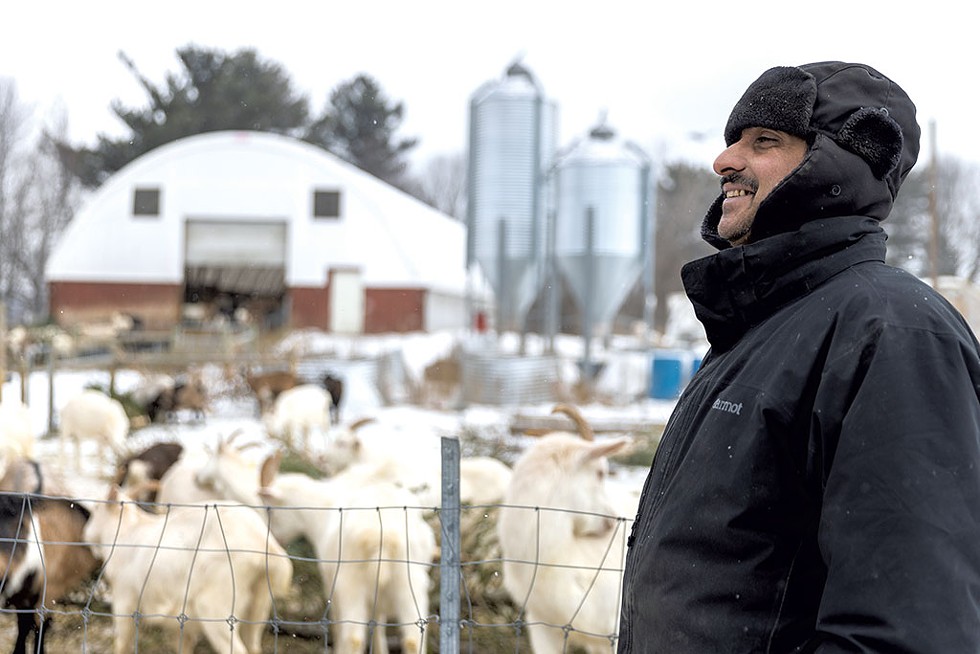
- James Buck
- Chuda Dhaurali of Dhaurali Goats at Pine Island Community Farm
The Foodbank has traditionally measured its impact, at least in part, by touting how many pounds of food it distributes. The pandemic accelerated a shift that had been slowly gathering momentum, said Andrea Solazzo, the Foodbank's director of community engagement. "We're not looking at pounds as much. We're trying to look more at what people want and need," she said. "We don't want to just be giving out that government cheese everybody talks about."
Implicit in the new approach is the recognition that not everyone wants and needs the same foods. Since the pandemic, NFACT data from Vermont indicate that food insecurity is at least five times as likely to affect BIPOC and Hispanic households. Solazzo has been leading efforts to better address the needs of those Vermonters, including New Americans, recently resettled refugees and migrant farmworkers.
The Foodbank has always worked with community partners, but the pandemic prompted more collaborations with organizations and businesses that are deeply embedded in communities of color. The projects have also made it a priority to buy foods from businesses and farms owned by New Americans.
Samuel Dingba, youth program coordinator and case manager for AALV, a Burlington nonprofit that serves New Americans, delivered food all over town to more than 80 families early in the pandemic. Too often, it was unfamiliar or unpalatable to them, said Dingba, who is originally from Cameroon. "They would take the food, but I'm pretty sure they would not eat it. They never ate broccoli before," he said, chuckling. With funding from a variety of sources, Dingba said, he was able to purchase groceries from local African markets, thereby supporting small minority-owned businesses while providing familiar foods to the immigrant families.
Several other projects offered similar dual benefits, including one with Dhaurali Goats, a Colchester meat goat farm that sells live animals to customers who then slaughter them in an on-farm facility. Chuda and Gita Dhaurali started the venture in 2013 on Pine Island Community Farm, which is owned by the Vermont Land Trust.
Chuda Dhaurali showed Seven Days around his farming operation on a recent freezing cold day. A large pile of discarded Christmas trees blocked the view of an outdoor pen. The evergreens make perfect forage, and several hardy goats had ventured out from the barn to nibble a few of the bushy trees into skeletons of branches.
Last summer, the Land Trust, the Foodbank and Feeding Chittenden collaborated to publicize and distribute $200 gift certificates to almost 40 families to use toward purchasing one of the Dhauralis' goats. "That would be a very small goat," Dhaurali, 43, said with a smile, explaining that most customers applied the certificate to offsetting about half the cost of a larger goat that would yield 70 to 90 pounds of meat.
Many of his regulars are originally from Africa, including Somalia and the Congo. Others came to the U.S., as the Dhauralis did, after being forced to leave Bhutan and spending years in Nepalese refugee camps. "They have been eating goat for a very long time," Dhaurali explained. They also prefer to see a live animal before buying it, a largely unmet need in Vermont agriculture before Dhaurali Goats.
Business was growing steadily until it screeched to a stop with the pandemic. It was a tough time for the Dhauralis and their customers. "Lots of people, they needed meat," Dhaurali said. "Some people didn't have enough money for food."
The mother of a Burlington family of six originally from Djibouti, who preferred not to share her name, said via an interpreted email interview that she cooks goat many different ways and was very grateful for the certificate. "I saved $200 to buy other stuff I need," she said.
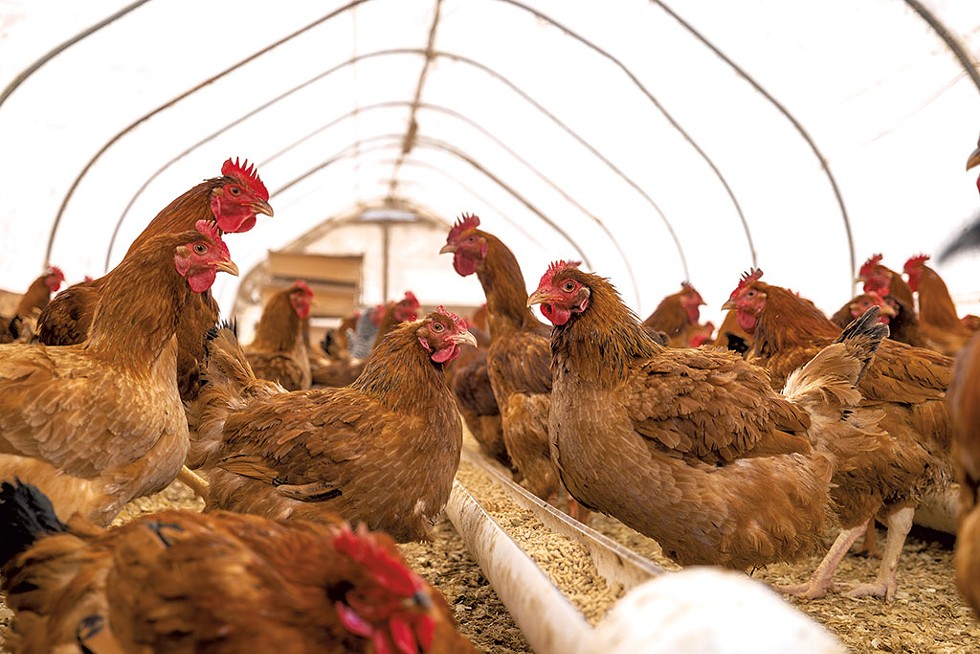
- James Buck
- Chickens farmed by Théogene Mahoro at Pine Island Community Farm
Beyond the pen of goats, a small flock of chickens strutted among large ice cubes cut from their frozen water bowls. The poultry belong to Théogène Mahoro, a farmer originally from Rwanda. His pandemic-impacted business benefited from a Land Trust/Foodbank collaboration that purchased and processed almost 800 birds that were given away in Burlington and Winooski. The Foodbank also worked with partners to distribute 1,000 pounds of African eggplant purchased from Janine Ndagijimana, another Colchester farmer from Rwanda.
This year is the third that the Foodbank will contract with Diggers' Mirth Collective Farm in Burlington to fill a 55-share CSA that includes collards and molokhia greens for members originally from Africa, and bitter melon and snake gourds for those from Nepal. The farm also grows jicama and epazote to include in 15 Foodbank-supported shares delivered twice monthly to Addison County migrant farmworkers.
Hilary Martin, a co-owner of Diggers' Mirth, said the CSAs meet the collective's longtime goal to provide fresh, locally grown food to everyone. She added that the steady income helped the farm make it through the first unsettled summer of the pandemic, when some farmers markets were canceled and a major catering account evaporated.
Lunch Line
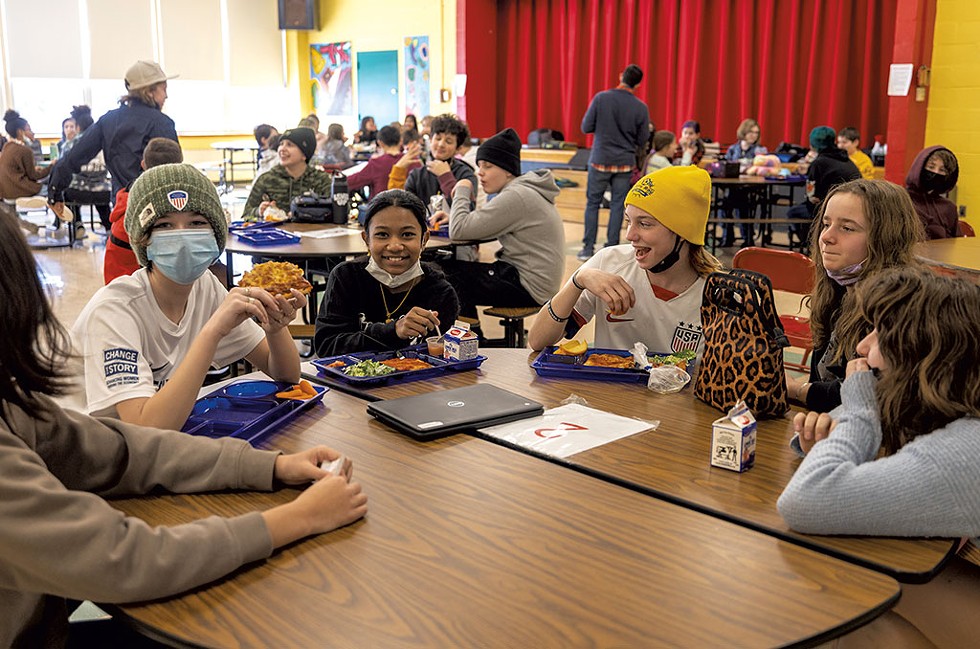
- James Buck
- Sixth-grade lunch at Essex Middle School
When schools switched to remote learning in the spring of 2020, their lunch programs continued and became a critical source of food for many families. Under an emergency federal authorization of what is called "universal meals," school lunches have been free during the pandemic to every child, whatever their household income, and will remain so through June 2022. This crisis-driven test pilot has provided longtime Vermont advocates of universal school meals more evidence of its benefits.
Kate Murphy, 39, of Essex Junction remembers vividly how it felt to pick up the free school meals. She or her husband, Patrick, would pile their four kids, now aged 4 to 10, into the minivan and head over to school. "We could wave at our favorite school nurse when she handed out the daily lunches, or wave to our friends who were there getting food at the same time," Murphy recalled. "It was a small but very vital way we could all still feel connected, even when we were separated."
Murphy and her husband also welcomed the savings on their weekly grocery bill. Murphy works full time for a local trust company, and her husband cares for their children, including their eldest with special needs, during the day when they're not in school. He worked evenings at Koffee Kup Bakery in Burlington before it closed unexpectedly in April 2021. Even after that, Murphy said, "We make just enough to be disqualified from most assistance programs but too little to really ever feel comfortable financially." Free, healthy school meals "have helped our stress levels immensely," Murphy said.
The Murphys fall in the significant pool of those who sometimes struggle to make ends meet but don't qualify for free or reduced-price school meals. Worse off are another large group of kids who could eat for free but don't, due to their own shame or that of their parents.
The education and advocacy group Hunger Free Vermont has been working for a decade to marshal arguments for universal meals. The Essex Westford School District, where the Murphy children attend school, offers a compelling case study — all on a federal dime, thanks to the pandemic.
Ideally, school food programs are self-funding, which means they try to sell enough meals to cover their costs. This includes free and reduced-price breakfast and lunch, paid for by the federal government. Many cafeteria costs are fixed, so the more meals children eat, the better chance of breaking even. To try to balance the budget, many schools sell snacks and drinks. (Incidentally, that's how the lunchroom crowd learns who the "free lunch kids" are — they're the ones who don't have money to buy extra snacks.)
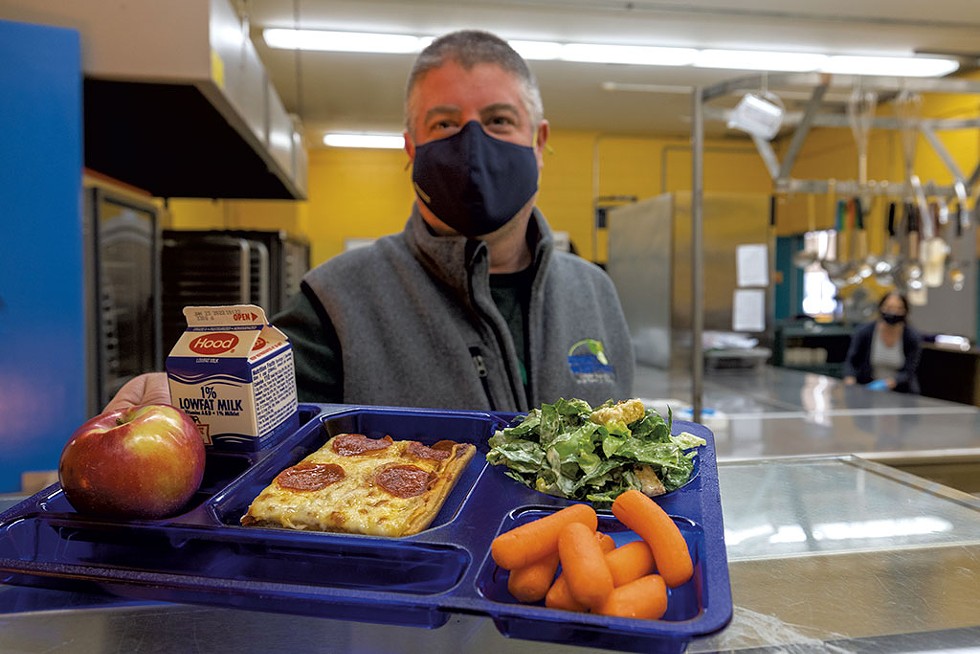
- James Buck
- Scott Fay, district senior child nutrition manager, at Essex Middle School
When all kids can get free meals, more eat them, generating more government reimbursements. In the Essex Westford district, which has 10 schools and 3,900 students, the number of meals served is up by 67 percent over pre-pandemic levels. The number of students who get lunch has increased from half to nearly three-quarters.
The revenue increase has allowed Scott Fay, the district's senior child nutrition manager, to eliminate the distracting and stigmatizing snack program. His staff no longer work as cashiers or spend time chasing down overdue student accounts. They are free to focus on cooking the best meals possible — for everyone.
As Fay reminded parents during the early pandemic meal pickups, "Funding is based on participation, so the more people that take the free meals, the stronger we can be for those that need us the most." Free school meals "only work if it's for everybody. That's how we destroy the stigma," he said. "When everybody shows up, it's normalized.
"COVID's been a big reset," Fay continued. He had just ordered 800 pounds of Misty Knoll drumsticks to serve with homemade focaccia and maple-roasted carrots.
"We pay for pens, paper, computers. We're not sending kids invoices for toilet paper," Fay observed. "Why do we stop at food?"
Rural Relief
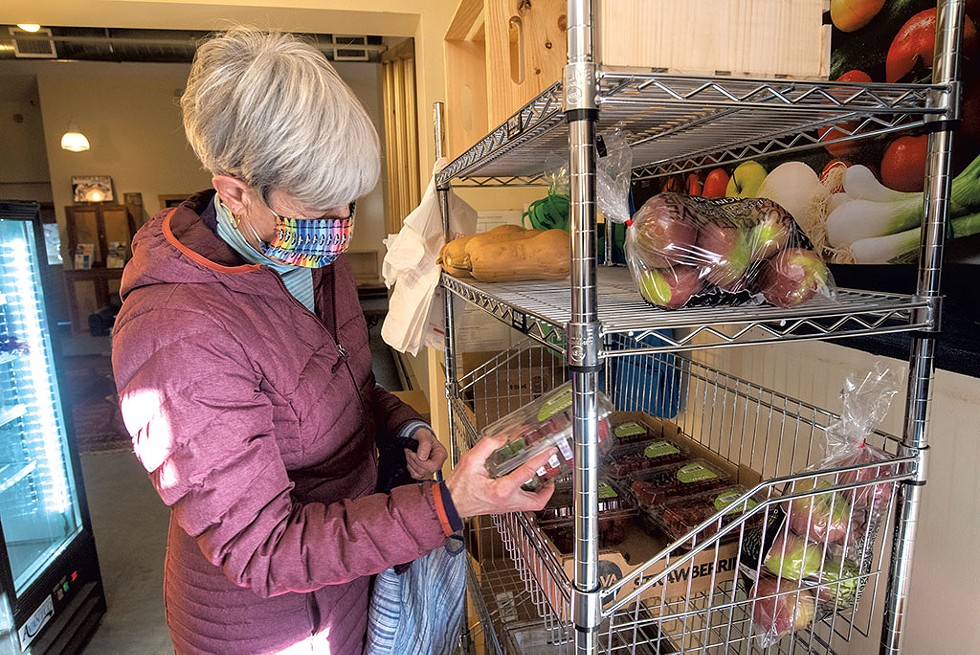
- Jeb Wallace-Brodeur
- Cindy Allen, of Chelsea, picking up free produce at the Orange County Parent Child Center in Tunbridge
As the pandemic persisted, Capstone Community Action, a central Vermont social services agency, invested in food freezers.
The freezers were one answer to the question, "How can we get food out to the rural, most isolated families and individuals?" according to Capstone executive director Sue Minter. Food-insecure Vermonters who live in rural areas, she pointed out, face additional hurdles finding food assistance because of their distance from centralized resources and, often, lack of reliable transportation.
So Capstone bought and placed freezers in far-flung towns, including Eden, Albany and Tunbridge, working closely with community health centers and other hometown hubs such as churches and schools. Those freezers enable prepared meals, mostly from Everyone Eats restaurant participants, to be stored safely until people can pick them up on their own schedule.
"Food that needs to be cooked doesn't serve the needs of many, many people who are food-insecure," Minter said.
A 45-year-old self-employed carpenter named Dave talked with Seven Days while waiting in his car to pick up his first grader from the school bus. Some days he will go from there to pick up Everyone Eats meals, vegetables and pantry staples at the Health Center, a clinic in his Plainfield hometown. Dave is not ashamed to get help, but he asked to be identified just by first name to protect his and his son's privacy.
"There is stigma. There shouldn't be, but there is," he said. "It's not a lot to ask society to make sure everyone has the basic necessities taken care of. It's not a terrible thing to help people."
Dave shares custody of his son with his ex-wife. Just before the pandemic, he had taken on a new mortgage to buy her share of their house. That made the sudden loss of income during lockdown especially stressful, he said. He learned from his son's school newsletter that the Health Center was offering food assistance. The center is where he gets medical care; it's a familiar, convenient spot that fits into his work-parenting juggle. The closest supermarket is almost an hour round-trip drive.
"I don't have a lot of time to chase down services," he said. "If I hadn't had [the food], I would've gotten behind in my bills and had to make some hard choices."
Father and son have had fun learning about new vegetables together. "My kid loved the shishito peppers," Dave said with amazement. After one pickup, he recalled, "My son said, 'I like it when that bag comes because it makes me feel like we're rich in food.'"
The Health Center philosophy is that "food security is a huge part of health and well-being," said Isabel Senter, a mental health counselor who took on a new role as outreach coordinator for the center when the pandemic hit. She works with several regional organizations, including Capstone, to offer free, weekly vegetables from the Vermont Youth Conservation Corps farm in Richmond, groceries from Cabot's Faith in Action, and Everyone Eats meals cooked by the Den at Harry's Hardware in Cabot and Joe's Kitchen in Montpelier. At the peak of pandemic need, Senter distributed 30 vegetable shares and bimonthly bags of staples, plus 300 meals every week. Recently, she's seen demand tick up again.
"I'm always asking if there's a waiting list, especially if there's someone who needs it more than me," Dave said. His income has stabilized, but he appreciates the time-saving meals and the budget help as grocery prices have soared to "jaw-dropping" heights.
His son is in aftercare until 5:30 p.m. and in bed by 7 p.m. "I don't know how I would make it all work if I had to make meals from scratch," Dave said. The pair often share one meal: maple pork sausage with black beans, cheese and rice from the Den, or chicken pot pie filling from Joe's Kitchen. Then they play games and read stories — "It's time to just be a dad," Dave said.

- Jeb Wallace-Brodeur
- AmeriCorps member Ashley Giron delivering food from Capstone Community Action to the Orange County Parent Child Center
Forty-five minutes south of Plainfield, on a stretch of Route 110 with no cell service and few houses, the Orange County Parent Child Center in Tunbridge provides a variety of family services, including childcare, playgroups and a diaper bank. On a recent morning, a cooler provided by Capstone and shelves in the center's entryway were filled with freshly delivered, local produce from the Foodbank: butternut squash, turnips the size of a baby's head, bags of potatoes grown in Williamstown and apples from Shoreham. Through many efforts, including distributions such as these, the Foodbank has tripled local farm purchases during the pandemic to about $1.5 million in 2021, a boost to the agricultural economy and to Vermonters in need.
The prepared meals freezer, also funded by Capstone, is in the childcare center kitchen, from which the mouthwatering smell of grilled cheese and homemade tomato soup seeped into the light-filled atrium. On days when the meals, grocery staples or produce are delivered, word goes out on social media, and the phone starts ringing with people calling to sign up.
One regular since the onset of the pandemic is Cindy Allen, who lives just down the road in Chelsea. The 63-year-old grandmother of eight left her job as a high school math teacher when her daughter couldn't find a daycare slot for her infant, born last spring. "Another crisis," Allen said. She's since been on call as backup care for all her grandchildren, a vital family service these days when a runny nose sends a toddler home to isolate.
Allen's husband worked on the family dairy farm when her kids were growing up. He still works, but the couple misses Cindy's paycheck. She estimates that inflation has driven up her grocery bill by at least 25 percent.
She appreciates the prepared meals, such as baked macaroni with ham, that she gets from the Tunbridge parent-child center, but she especially values the produce. Without it, "we wouldn't be eating as many fruits and vegetables," Allen said. Her point is backed up by NFACT data that show one-third of food-insecure research respondents in Vermont reported a decrease in fruit and vegetable consumption during COVID-19.
Early in the pandemic, Allen volunteered to help with the Farmers to Families food box distribution. "People were scrambling for food," she recalled. "It was so heartbreaking." In the summer, she and her husband grow a big garden and put extras out with a "By donation" sign.
"Healthy food should not be a privilege," Allen said.
Keep the Fires Burning
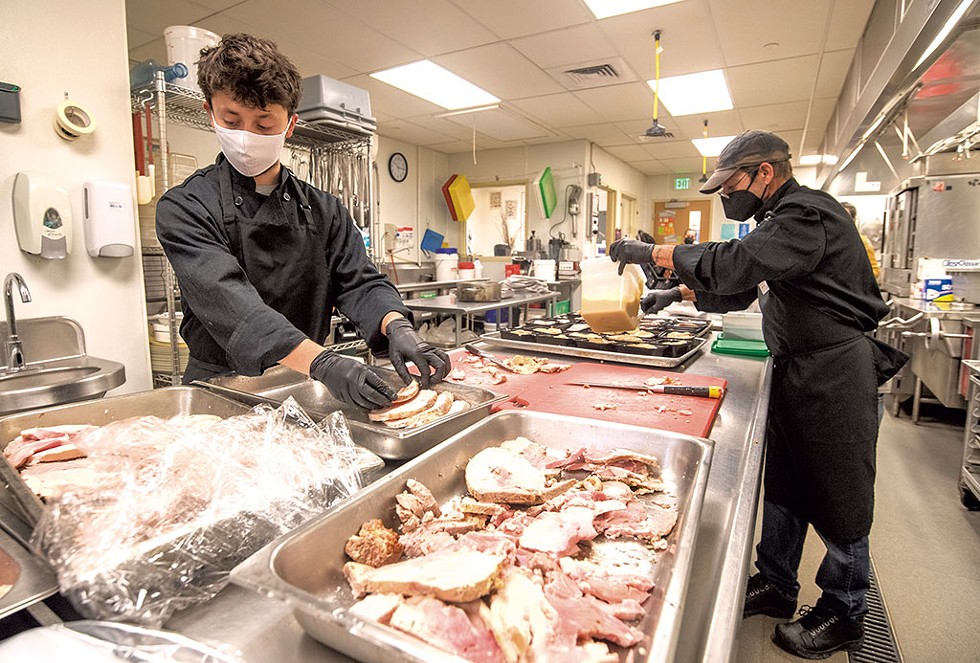
- Jeb Wallace-Brodeur
- Victor Maldonado (left) and Pauly Falco working in the Culinary Kitchen Academy at Capstone Community Action in Barre
For the week of January 17, the prepared meals delivered to the Orange County Parent Child Center came from Capstone's teaching kitchen in Barre as part of a pilot program that applies and builds on lessons learned from Everyone Eats.
The effort is among the earliest to test how Vermont might adapt and continue pandemic food assistance innovations after the federal government turns off the faucet.
On January 13, Pauly Falco, 51, of Randolph, and Victor Maldonado, 19, of Berlin, were working in the kitchen filling takeout containers with roasted turkey, gravy, mixed rice, green beans and beets. Falco is a recent graduate of Capstone's Culinary Kitchen Academy, which is modeled after a free job skills training program at Feeding Chittenden. The students put out 135 meals a week while they're learning. Maldonado is a new student in the latest cohort. Asked why he had signed up for the seven-week course, the young man said softly, "I can do something for myself and be helpful to others."
"We've learned a really powerful lesson in this pandemic," said Anore Horton, executive director of Hunger Free Vermont. "People want to feel that they are contributing, not just taking."
Hunger Free Vermont is gearing up to lobby in Montpelier for a bill that would make universal school meals permanent. They estimate that it would cost the state $15 million to $25 million a year to supplement federal funding and offer free school breakfast and lunch statewide to every child. Horton believes the pandemic has demonstrated that universal meals can make school food programs a stronger resource for every family, regardless of income.
Feeding Chittenden is rolling out an electronic grocery ordering system that can be translated into 30 different languages, with filters for Halal and vegetarian options. The nonprofit has been working closely with partners at the Janet S. Munt Family Room, a parent-child center in Burlington, the UVM Medical Center pediatrics department and Head Start to help families navigate the new technology, which will offer more private, customizable and efficient delivery and pickup of groceries.
The Foodbank has ambitious plans to keep working on better ways to address and reduce hunger, thanks to a surprise $9 million gift received in December 2020 from MacKenzie Scott, the ex-wife of Amazon founder Jeff Bezos. At the time, Sayles called it "transformational." The money has helped the Foodbank stay the course in the face of inflation and staggering need. Refocused on the future, the nonprofit will soon launch two initiatives inspired partly by pandemic learning.
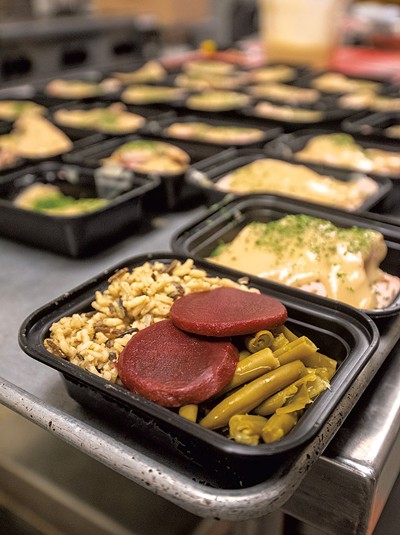
- Jeb Wallace-Brodeur
- Meals at the Culinary Kitchen Academy at Capstone in Barre
One is called "deep community work," Sayles explained, and takes its cue from the vigorous mutual aid response to the pandemic. Over the next two years, the Foodbank will work with three underserved Vermont communities to bring them resources and learn how they would apply those to addressing food security. The other initiative is an "innovation lab" effort that will identify promising efforts at food banks around the country to adapt for possible pilot projects in Vermont.
"We're trying to figure out, without ... that huge amount of [federal] funding, how do we keep those little fires of inspiration burning?" Sayles said.
On January 9, Seleste Weeks hiked Spruce Mountain with her two standard poodles to celebrate her one-year anniversary working at Four Paws Inn. She also ordered takeout chicken and dumplings from the Wayside restaurant in Montpelier through the Localvore Passport app.
Weeks hopes she'll be able to continue stretching her budget with the free restaurant meals. If the program stops completely when its latest round of federal support ends on April 1, Weeks said, she'll probably have to head back, reluctantly, to the food shelf at the end of each month.
Vermont Emergency Management recovery and mitigation chief Ben Rose has worked closely with the Everyone Eats team to secure FEMA dollars. He believes that the program has the potential to change the model for food assistance programs beyond COVID-19 and noted that it recently attracted the attention of the USDA.
"If we can make sure that everybody has a hot meal during a global pandemic, shouldn't we be able to do that when the pandemic ends?" Rose asked rhetorically. "Whenever there's a family going hungry, that's a food emergency."

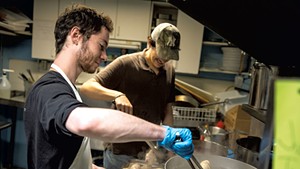
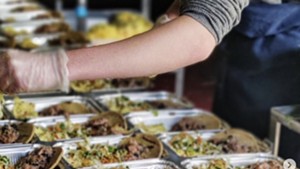
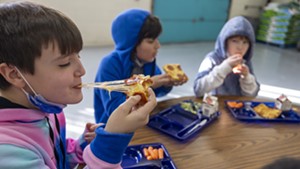










Comments
Comments are closed.
From 2014-2020, Seven Days allowed readers to comment on all stories posted on our website. While we've appreciated the suggestions and insights, right now Seven Days is prioritizing our core mission — producing high-quality, responsible local journalism — over moderating online debates between readers.
To criticize, correct or praise our reporting, please send us a letter to the editor or send us a tip. We’ll check it out and report the results.
Online comments may return when we have better tech tools for managing them. Thanks for reading.